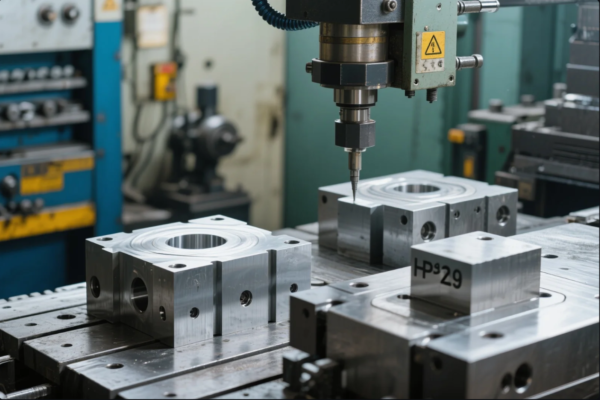How do you identify metal parts?

When you're sourcing metal components, it's crucial to know how to properly identify and assess them. If you're struggling with quality control or verifying metal types, you're not alone. Many engineers face this challenge when it comes to sourcing metal parts for their projects.
Snippet paragraph: Identifying metal parts involves assessing key characteristics like material type, grade, and quality. Here's how you can do it effectively.
Transition paragraph: Let’s dive into how you can easily identify and inspect your metal parts to ensure they meet your needs.
How can I identify a piece of metal?
Identifying a piece of metal seems simple, but it involves various factors like visual inspection, testing, and knowing the key properties of the material. Metal identification can help you avoid costly mistakes and ensure that the components you receive meet your project’s requirements.
Snippet paragraph: Metal parts identification requires understanding their appearance, density, and chemical composition. Learn how to quickly recognize key properties.

Visual Inspection and Physical Properties
The first step in identifying a metal part is visual inspection. Different metals have distinct visual characteristics such as color, texture, and finish. For instance, stainless steel is shiny and often has a smooth finish, while aluminum tends to be more matte. But don’t stop there; you also need to check physical properties.
Weight and Density: One of the easiest ways to differentiate metals is by their weight. If you have two metals of the same size, their weight can indicate whether you're looking at aluminum, steel, or another material. Metals like titanium are very lightweight compared to iron-based alloys.
Magnetism: Magnetic properties are useful for identification. For example, ferrous metals like iron and steel are magnetic, while non-ferrous metals such as aluminum, copper, and brass are not.
Surface Finish and Color
The surface finish and color of a metal part can tell you a lot about its type. Stainless steel, for example, often has a shiny, smooth surface, while aluminum parts may have a more matte or dull finish. The color also helps – copper is reddish-brown, aluminum has a silver-white hue, and steel usually has a darker color depending on the alloy.
Chemical Composition Testing
One of the most accurate ways to identify a metal is by analyzing its chemical composition. This can be done using techniques like spectroscopy, where the metal is heated and its spectrum analyzed for specific elements.
Common Testing Methods for Metal Identification
| Method | Description |
|---|---|
| X-Ray Fluorescence | Measures the chemical composition of metals. |
| Spark Testing | Observes sparks when the metal is ground to identify its alloy. |
| Magnetic Test | Determines if the metal is magnetic, which helps identify ferrous metals. |
LOOP_END
How metals can be identified?
Identifying metals goes beyond just appearance and weight. You need to understand the detailed properties of the material to ensure that it will perform correctly for its intended use.
Snippet paragraph: There are multiple ways to identify metals, ranging from chemical analysis to physical property testing. Here's a guide to understanding the full process.

Chemical Analysis
The most definitive way to identify metals is through chemical analysis. This method gives you an exact breakdown of the material’s composition. Spectroscopy and X-ray fluorescence (XRF) are commonly used for this purpose. These tools can quickly tell you the percentages of various elements in a metal sample, helping you distinguish between alloys.
Physical Tests for Identification
Apart from chemical analysis, some simple physical tests can help you identify a metal's type:
Hardness Test: This test determines how resistant the metal is to surface indentation. Steel, for example, is typically harder than aluminum.
Tensile Test: By pulling the metal apart, you can determine its strength and ductility, which is important when identifying metals used in structural applications.
Electrical Conductivity: Copper and aluminum are excellent conductors of electricity, while other metals like steel are poor conductors.
Visual and Sensory Examination
In addition to tests, experienced engineers rely on a metal's appearance and tactile sensations for identification. Some metals like brass or bronze will feel slightly warmer or smoother to the touch compared to iron or steel.
LOOP_END
How do you inspect sheet metal parts?
Sheet metal parts are used in a variety of industries, from automotive to aerospace, and inspecting them requires a few specific checks. Ensuring your sheet metal is up to standard is essential for product performance.
Snippet paragraph: Inspecting sheet metal parts requires checking for defects such as warping, thinning, or incorrect dimensions. Let’s explore how to do it right.

Visual Inspection for Surface Defects
The first step in inspecting sheet metal is a thorough visual inspection. Look for any obvious defects such as scratches, dents, or discoloration. These issues can compromise the part’s integrity and performance.
Dimensional Accuracy
Checking the dimensions of sheet metal parts is crucial. A part that’s slightly too big or small can cause significant issues during assembly. You can measure using tools like calipers, micrometers, or laser measuring devices.
Thickness and Flatness
The thickness of the sheet metal should be uniform across the entire part. Variations in thickness can cause problems during manufacturing and reduce the part’s strength. Additionally, ensure that the part is flat. Warped or bent sheets won’t meet engineering requirements.
Surface Finish Quality
The surface finish is also an important aspect of inspection. A poor finish can lead to corrosion or mechanical failure in some environments. You should also verify the coating or plating if it's part of the design.
Non-Destructive Testing (NDT)
For more critical applications, NDT methods like ultrasonic testing or X-ray inspection are used. These techniques allow you to detect internal defects without damaging the part.
LOOP_END
How do you check metal grade?
Knowing the grade of metal you're dealing with is essential for ensuring it meets the strength and performance requirements for your project. Here’s how you can check it.
Snippet paragraph: Checking the grade of a metal part requires reviewing material specifications and performing tests like hardness or tensile strength. Let's look at how to do it effectively.

Material Specifications and Standards
Each type of metal comes with specific standards that define its grade. For example, steel grades are often indicated by a number that corresponds to its alloy content and strength properties. For instance, stainless steel may be marked as 304, while carbon steel may be marked as A36.
Tensile Strength Test
One of the best ways to assess the grade of a metal is by measuring its tensile strength. This test involves stretching the metal until it breaks and recording the maximum stress it can handle before breaking. Higher grades of steel and aluminum will have better tensile strength, making them suitable for heavy-duty applications.
Hardness Testing
Hardness tests, such as the Rockwell or Brinell tests, are often used to determine metal grade. Harder metals usually have higher grades, but they may also be more brittle.
Chemical Composition
As mentioned earlier, the chemical composition of a metal directly impacts its grade. Using X-ray fluorescence or other methods, you can determine the metal's exact makeup and compare it to established standards for its grade.
LOOP_END
Conclusion
Identifying and inspecting metal parts is essential for ensuring they meet your project’s requirements. Always check properties such as composition, grade, and physical characteristics to guarantee quality and performance. Reach out to Prime for expert guidance and high-quality metal parts that meet global standards.







